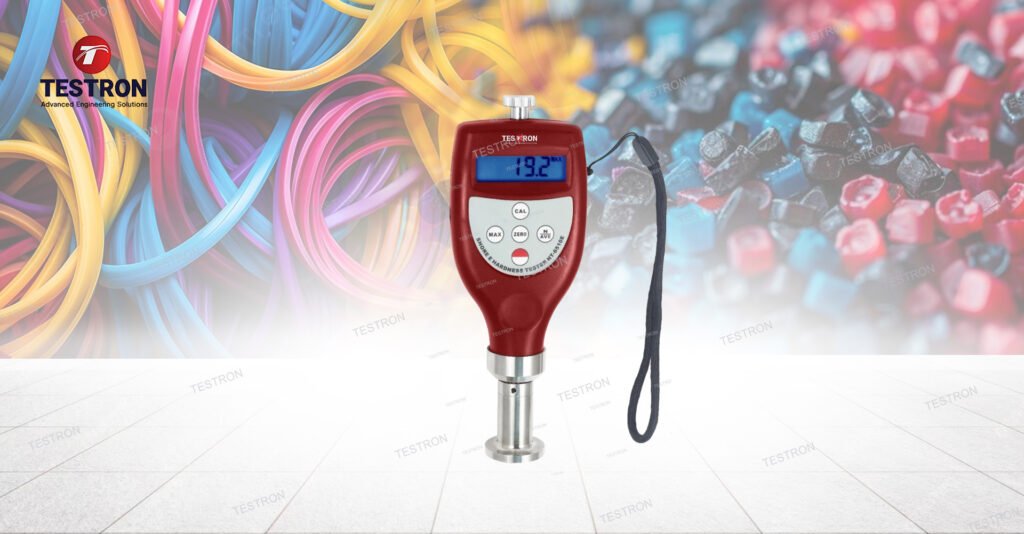Industries related to plastic and rubber manufacturing are thriving across various parts of Australia. With the right quality control tool, they can assess the indentation hardness of non-metallic materials.
Precision and quality of the equipment depend on the level of maintenance. To keep the functionalities of the shore hardness tester for rubber and other materials, on-time calibration is necessary.
Unlock the full potential of your materials—discover why calibration is the key to quality with the best Shore hardness tester for rubber and plastic in Australia!
What is a Shore Hardness Tester & Its Applications?
Testron’s TT-5430 rubber shore hardness tester is the ideal tool for operators to check the hardness of soft rubber, neoprene, elastomers, silicon, and other harder materials, such as PVC and hard plastics.
This digital shore hardness tester targets medium to hard rubbers and rigid plastics often used in structural applications. The advanced features of Testron’s plastic and rubber testing equipment, TT-5430 shore hardness tester for plastic and rubber materials are giving the best results to the operators and adding more value in the quality management of production.
Ready to measure the true strength of your materials? Explore which Shore hardness tester matches your specific needs in Australia!
Technical Key Features of a Shore Hardness Tester in Australia
Testron’s manufacturing is strongly based on providing accuracy and reliable performance for a longer time. However, without the right specifications, features, and engineering, the device may fail to provide the best performance.
Industrial users and lab experts call Testron’s TT-5430 the “Best shore hardness tester.” Well, there are reasons behind this. The following features and specs have grabbed their attention:
- Built-in displacement sensors.
- Two testing modes.
- Easy to operate.
- Better portability.
- Smooth setup.
- USB interface for PC connectivity.
- Store up to 200 groups of average peak values.
- Auto power off to save energy.
- 1.3-inch OLED screen.
Some technical features of a Shore Hardness Tester in Australia are mentioned below:
- Measuring range: 0 ~ 100HD
- Tolerance: ≤±1 HD (within 20 ~ 90HD)
- Power: Built-in rechargeable Li battery
- Resolution: O.1HD
- Weight: 200g
- Dimensions:173mm x56mm x 42mm
How To Calibrate Shore Hardness Testers?
The shore hardness tester calibration steps are easy to follow when guided by experts. At Testron, we have the best team that addresses such issues for clients and businesses worldwide.
In Australia, we also aid in the calibration of a shore hardness tester with proper guidance. The following steps are simple to implement and complete your shore hardness tester calibration effortlessly:
- Use certified test blocks.
- Always verify the reference readings.
- Check the zero and maximum hardness points.
- In Zero Calibration:
- Hold the tester vertically.
- Make sure to avoid any contact.
- Confirm the reading is zero.
- Make necessary adjustments if necessary.
- High-end calibration:
- Require firm contact with a flat glass/reference block.
- Check the reading.
- Align everything closely.
- Stamped reference values.
- Record all the documents.
- Make sure to include corrections and deviations.
Upgrade lab precision with Testron’s shore hardness testing machine —follow the best and proven calibration steps and guarantee reliable performance of a shore hardness tester in Australia for every test!
Tips for Ensuring Consistent Calibration
The performance of the best shore hardness tester requires the necessary calibration and maintenance over time.
Different factors influence the performance of a shore hardness tester in Australia, such as:
- Heavy usage.
- Environmental conditions.
- Criticality of measurements.
To counter all the odds and achieve higher accuracy from a shore hardness tester in Australia, the following tips are provided:
- After heavy checks, schedule the calibration.
- Go for calibration during significant transfer and mechanical impacts.
- Clean the presser and indentors to avoid drift during the measurement.
- Calibrate the device when it is in controlled environments.
Get ahead of quality lapses—follow these expert calibration habits and keep your hardness tester ready for any rubber or plastic challenge!
Industrial Applications of a Shore Hardness Tester in Australia
The calibrated mechanical and electrical devices are always performing great under tough conditions by providing accurate and reliable results. The following industries are interested in using the shore hardness testers in Australia:
Non-Metalic Materials
- Soft rubber,
- Neoprene,
- Elastomers,
- Silicone, etc.
Harder Materials
- Hard plastics,
- Hard rubber,
- Epoxies,
- Acrylic,
- PVC, etc.
Power your industry with precision! See how the Testron’s shore hardness tester in Australia directly impacts quality and safety in rubber and plastic products.
Read more: How Premium Shore Hardness Testers Solve Your Toughest Testing Challenges
Conclusion
Always remember, investing in the right shore hardness tester in Australia is always recommended. However, finding the ideal product within a suitable shore hardness tester price range is no longer a problem.
With Testron’s shore hardness tester in Australia, businesses can meet demanding client specifications while reducing the risk of costly errors or recalls.
Ready to perfect your material testing? Choose a calibrated Shore hardness tester from Testron and guarantee peace of mind for every product you produce! For more info, reach out to us at info@testrongroup.com.
FAQs About Shore Hardness Tester in Australia
– Regular cleaning,
– Visual checks of the indicator,
– Scheduled calibration, and
– Storing the device in a controlled environment.
– DIN53505,
– ASTM D2240,
– ISO 7619, and
– JIS K7215.


